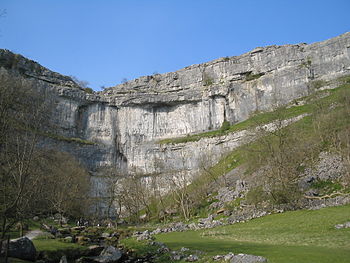Malham Cove
Malham Cove is a large curved limestone formation in the Yorkshire Dales, in the West Riding of Yorkshire half a mile north of the village of Malham.
The formation was formed by a waterfall carrying meltwater from glaciers at the end of the last Ice Age more than 12,000 years ago. Today it is a well-known beauty spot.
A large limestone pavement lies above the cove.
Geology
The cove was formed by a large Ice-age river that fell at this point as a cataract. The water drop would have been 260 feet down and a thousand feet wide. The water flowing over the waterfall created the curved shape of the cove because the lip was more heavily eroded than the sides.
Today the water course here is marked by a stream that flows out of Malham Tarn a mile and a half north of the cove. It runs underground at 'Water Sinks' about a miles before the top of the cove. Another stream named Malham Beck emerges from a cave at the bottom of the cove. The two streams were once thought to be one and the same, but experiments with dyes have shown that they are two separate waterways that sink underground at different places. Their paths cross without mixing behind the limestone cliff, re-emerging a few miles apart. The experiments show that there is a complex system of caves and tunnels in the limestone cliff. The system is estimated to be about 50,000 years old. Cave divers, entering the system through the cave at the base of the cove, have so far explored for about a mile.[1]
The cave systems usually carry away any water before they reach the edge of the cliff of Malham Cove. However on 6 December 2015, Malham Cove temporarily became a waterfall for what is believed to be the first time in centuries. Heavy rainfall from Storm Desmond swelled the streams and a waterfall plunged down ther cliff. [2][3] Its height of 260 feet, for a few hours, made it the highest "single drop waterfall" above ground in England.
History
The priest and noted antiquary, Thomas West described the cove in 1779 as, "This beautiful rock is like the age-tinted wall of a prodigious castle; the stone is very white, and from the ledges hang various shrubs and vegetables, which with the tints given it by the bog water. & c. gives it a variety that I never before saw so pleasing in a plain rock."[4]
On the west side of the 260 foot high cliff face are about 400 irregular stone steps: these form part of the route of the Pennine Way and lead to an uneven limestone pavement at the top.
Today the cove is very popular with climbers because of its number of climbing routes (many of which can be ascended in the rain). They include easy to hard traditional climbs as well as sport climbing. Due to the cliff's south face, it is a popular venue for rock climbing in winter, its aspect making it a sun trap; in summer, however, the rock face can become unbearably hot.[5]
Media appearances
The cove, along with nearby Gordale Scar, was featured in an episode of the BBC TV series Seven Natural Wonders as one of the natural wonders of Yorkshire.[6]
The Pavement was used as a shooting location for the 1992 film version of "Emily Brontë's Wuthering Heights"[7]
The cove was also featured in the film Harry Potter and the Deathly Hallows (Part 1) as one of the places Hermione and Harry travel to. The scenes were filmed in November 2009.[8]
The limestone pavement and general location of Malham featured in an episode of The Trip starring Steve Coogan and Rob Brydon which aired on BBC2 on 29 November 2010.[9]
The cove is the bridgehead of an alien invasion in Charles Stross’ 2016 novel The Nightmare Stacks.
Gallery
Location
- Location map: 54°4’15"N, 2°9’31"W
- Streetmap: SD896639
Outside links
| ("Wikimedia Commons" has material about Malham Cove) |
References
- ↑ "Malham Cove by John Cordingley". http://www.cavedivinggroup.org.uk/images/Photos/JNC/Malham/index.htm. Retrieved 17 September 2008.
- ↑ Brown, Jonathan. "Video: Storm Desmond causes Malham Cove to become stunning waterfall for first time in centuries". Yorkshire Post. Johnson Press. http://www.yorkshirepost.co.uk/news/main-topics/general-news/video-storm-desmond-causes-malham-cove-to-become-stunning-waterfall-for-first-time-in-centuries-1-7609734. Retrieved 6 December 2015.
- ↑ "Malham Cove: Storm Desmond brings 'highest' waterfall back to life". BBC News. https://www.bbc.co.uk/news/uk-england-york-north-yorkshire-35024253. Retrieved 7 December 2015.
- ↑ West, Thomas (1784). A Guide to the Lakes in Cumberland, Westmorland and Lancashire. B. Shaw; Richardson and Urquhart. pp. 232–233. https://books.google.com/books?id=6BEPAAAAYAAJ&pg=PA241&lpg=PA241&dq=beautiful+rock+is+like+the+age-tinted+wall+of+a+prodigious+castle&source=bl&ots=-ERLQAieO-&sig=rugstzIj5fN_ciRirWaATpxY-Xs&hl=en&sa=X&ei=eWmrUa6uOMTBO4v_gCA&ved=0CDUQ6AEwAQ#v=onepage&q=beautiful%20rock%20is%20like%20the%20age-tinted%20wall%20of%20a%20prodigious%20castle&f=false.
- ↑ "Malham Cove". www.rockfax.com. 7 December 2015. http://www.rockfax.com/databases/results_crag.html?id=32. Retrieved 7 December 2015.
- ↑ "BBC - Seven Wonders - Malhamdale". http://www.bbc.co.uk/england/sevenwonders/yorkshire/malham/. Retrieved 9 January 2018.
- ↑ O'Neill, Jane (1997). The World of The Brontës. London: Carlton. p. 137. ISBN 1-85868-314-6.
- ↑ Newton, Grace (26 June 2017). "Harry Potter at 20: The Yorkshire locations used in the films". The Yorkshire Post. https://www.yorkshirepost.co.uk/news/harry-potter-at-20-the-yorkshire-locations-used-in-the-films-1-8616398. Retrieved 9 January 2018.
- ↑ "The Yorke Arms, England, The Trip - BBC Two". http://www.bbc.co.uk/programmes/b00wfhfp. Retrieved 9 January 2018.






